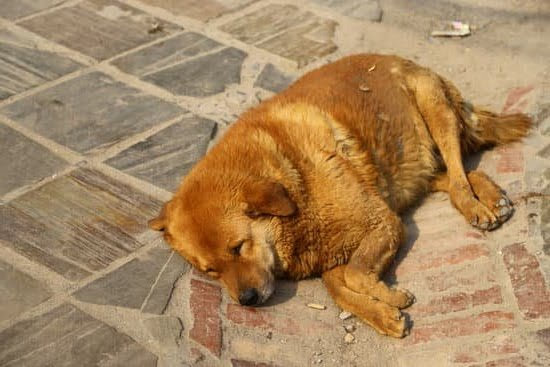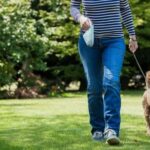Potty training an old dog can be a challenging task for many pet owners. Whether you have recently adopted an older dog or your senior canine companion is struggling with accidents, it’s essential to understand the unique challenges and considerations that come with potty training an older pup.
In this article, we will explore the reasons behind accidents in old dogs, establishing a potty training routine, using positive reinforcement, dealing with setbacks, creating a comfortable outdoor potty area, and seeking professional help for potty training.
Older dogs may have different needs and abilities when it comes to learning new behaviors, including potty training. Understanding the reasons behind accidents in old dogs is crucial in addressing their specific potty training challenges. Additionally, establishing a consistent potty training routine and using positive reinforcement are essential components of successfully teaching an old dog where to go potty.
Setbacks and accidents are common during the potty training process, especially with older dogs. Patience and consistency are key in overcoming these obstacles and helping your dog learn proper potty habits. Furthermore, creating a comfortable and accessible outdoor potty area tailored to your old dog’s needs can significantly aid in successful potty training. Lastly, seeking professional help or exploring alternative methods may be necessary for some older dogs who struggle with traditional potty training techniques.
Understanding the Reasons Behind Accidents in Old Dogs
As dogs age, they may experience certain physical and cognitive changes that can impact their ability to control their bladder and bowels. Understanding the reasons behind accidents in old dogs is crucial in effectively potty training them.
Physical Health Issues
Older dogs are more prone to medical conditions such as urinary incontinence, diabetes, kidney disease, and mobility issues, all of which can contribute to accidents indoors. It’s important to consult with a veterinarian to rule out any underlying health issues that may be causing the accidents.
Cognitive Decline
Just like humans, dogs can experience cognitive decline as they age. This may lead to forgetfulness or confusion about where they are supposed to eliminate. Senior dogs may also have difficulty holding their bladder for extended periods of time, leading to accidents inside the house.
Anxiety and Stress
Changes in the home environment, such as moving to a new house or the addition of new family members or pets, can cause stress and anxiety in older dogs. This stress can manifest in potty accidents as a form of marking or seeking comfort.
Understanding these reasons behind accidents in old dogs allows pet owners to approach potty training with empathy and patience. It also highlights the importance of addressing any underlying health issues before beginning a training regimen.
Establishing a Potty Training Routine for an Old Dog
When it comes to potty training an old dog, establishing a routine is crucial. Just like with puppies, consistency is key in teaching an older dog where and when to go potty. Start by taking your old dog outside frequently, especially after meals and naps.
Designate a specific area in your yard where you want your dog to relieve himself and take him there each time. This will help him understand what is expected of him and where he should do his business.
It’s also important to keep a consistent schedule for feeding and walks. By feeding your old dog at the same times each day, you can predict when he will need to go outside. Regular walks not only provide exercise but also give your dog the opportunity to eliminate outside. This routine will help regulate his bathroom habits and make it easier for him to understand when and where he should potty.
Lastly, be patient and give your old dog plenty of opportunities to succeed. It may take some time for him to adjust to the new routine, especially if he has been used to going potty inside the house. Keep a close eye on him while indoors and take him out immediately if he shows signs of needing to go. With patience and consistency, you can establish a successful potty training routine for your old dog.
| Key Points | Details |
|---|---|
| Routine | Consistency is important in teaching older dogs where and when to go potty. |
| Schedule | Regular feeding times and walks help regulate bathroom habits. |
| Patience | Old dogs may take time adjusting to the new routine, so be patient with them. |
Using Positive Reinforcement and Rewards in Potty Training
Old dogs can often be set in their ways, making potty training a challenging task for pet owners. However, using positive reinforcement and rewards can be an effective way to encourage good potty habits in older dogs. By providing praise, treats, or other rewards when the dog successfully goes to the bathroom in the designated potty area, you can help motivate them to repeat the behavior.
Understanding the Benefits of Positive Reinforcement
Positive reinforcement involves rewarding your old dog for exhibiting desired behavior, such as using the outdoor potty area. This method focuses on rewarding the dog’s good actions rather than punishing them for accidents. By providing positive reinforcement, you are creating a positive association with using the designated potty area and encouraging your dog to continue this behavior.
Implementing a Reward System
When using positive reinforcement in potty training an old dog, it is essential to establish a consistent reward system. This may involve giving verbal praise, offering favorite treats, or providing physical affection when the dog successfully eliminates in the right spot. The key is to make the reward immediate and meaningful to your old dog so they can effectively link their action with receiving a reward.
Using positive reinforcement and rewards in potty training an old dog requires patience and consistency on the part of the pet owner. It is important to stay committed to this method and avoid scolding or punishing your old dog for accidents. Instead, focus on encouraging and rewarding good behavior while maintaining a supportive and understanding approach throughout the training process.
Dealing With Setbacks and Accidents During Potty Training
Potty training an old dog can be a challenging task, as they may have developed certain habits over the years that are hard to break. Setbacks and accidents are common during the potty training process, but it’s important to remain patient and consistent in your approach. Here are some tips for dealing with setbacks and accidents during potty training:
1. Stay calm and avoid punishment: When accidents happen, it’s important to stay calm and avoid punishing your old dog. Yelling or scolding them will only create fear and anxiety, making the potty training process even more difficult.
2. Clean up accidents properly: Accidents are bound to happen, so it’s crucial to clean up any messes properly to avoid lingering odors that may encourage repeated accidents in the same spot. Use an enzymatic cleaner specifically designed for pet messes to thoroughly clean any soiled areas.
3. Revisit the basics: If your old dog is experiencing frequent setbacks or accidents, it may be necessary to revisit the basics of potty training. This means going back to a strict routine of taking them outside regularly, especially after meals or naps, and giving plenty of opportunities for them to do their business.
It’s important to remember that potty training an old dog takes time and patience. With consistent effort and positive reinforcement, you can help your old dog learn new habits and become successful in their potty training journey.
The Importance of Consistency and Patience in Potty Training an Old Dog
Potty training an old dog can be a challenging task, but it’s not impossible with the right approach. One of the most important aspects of potty training an older dog is consistency and patience. Just like with puppies, older dogs also need time to adjust to a new routine and understand what is expected of them.
To help with the process, here are some tips for being consistent and patient when potty training an old dog:
- Stick to a regular feeding schedule: By feeding your old dog at the same times each day, you can predict when they will need to go outside to potty.
- Take frequent potty breaks: Older dogs may have a weaker bladder, so it’s important to take them outside regularly, especially after meals or naps.
- Use verbal cues and positive reinforcement: Consistently using the same cue words when taking your dog outside to potty will help them understand what is expected. Additionally, rewarding them with praise or treats when they do their business outside will reinforce good behavior.
- Stay calm and patient: It’s important not to get frustrated or angry when accidents happen. Instead, focus on being patient and providing gentle guidance for your older dog.
Consistency and patience are key elements in successfully potty training an old dog. Remember that every dog is different, so it may take time for your furry friend to adjust to the new routine. With dedication and perseverance, you can help your old dog learn where they should do their business.
Tips for Creating a Comfortable and Accessible Outdoor Potty Area for an Old Dog
Older dogs may have special needs when it comes to potty training, and creating a comfortable and accessible outdoor potty area is essential in helping them succeed. One way to make an outdoor potty area more inviting for an older dog is to ensure that the surface is comfortable and easy for them to navigate. Some older dogs may struggle with mobility issues, so providing a flat and non-slip surface can be beneficial.
Another important aspect of creating a comfortable outdoor potty area for an old dog is to consider the environment and surroundings. Older dogs may be more sensitive to extreme temperatures, so providing shade during hot weather and shelter during rain can encourage them to use the designated area. Additionally, keeping the area clean and free of any debris or obstacles can also make the space more appealing for an older dog.
Furthermore, if a senior dog has specific health concerns such as arthritis or joint pain, it may be useful to provide a pathway or ramp leading to the outdoor potty area. This will assist them in getting there comfortably without having to navigate difficult terrain. Making sure that the outdoor potty area is easily accessible can help prevent accidents inside the house while accommodating any physical limitations that an older dog may have.
| Aspect | Consideration |
|---|---|
| Surface | Flat and non-slip surface |
| Environment | Shade/shelter from extreme weather, clean surroundings |
| Accessibility | Pathway/ramp for senior dogs with mobility issues |
Seeking Professional Help and Alternative Methods for Potty Training an Old Dog
In conclusion, potty training an old dog can be challenging, but it is not impossible. Understanding the reasons behind accidents in old dogs and establishing a potty training routine are key steps in successfully teaching an elderly dog where to go to the bathroom. Positive reinforcement and rewards play a crucial role in encouraging good behavior, while consistency and patience are essential for long-term success.
It’s important to remember that setbacks and accidents may occur during the potty training process. It’s crucial not to get discouraged and to continue with the established routine. Creating a comfortable and accessible outdoor potty area for an old dog can also help facilitate successful potty training.
If you find yourself struggling with potty training an old dog, don’t hesitate to seek professional help or consider alternative methods. A professional dog trainer or veterinarian may provide valuable insight and guidance on how to address your specific challenges. With patience, consistency, and the right approach, even an old dog can learn new tricks when it comes to where they do their business.
Frequently Asked Questions
Can an Older Dog Still Be Potty Trained?
Yes, older dogs can still be potty trained, but it may take more time and patience compared to training a puppy. Consistency, positive reinforcement, and establishing a routine are key factors in successfully potty training an older dog.
At What Age Is It Too Late to Potty Train a Dog?
It’s never too late to potty train a dog, but the process may be more challenging with older dogs compared to puppies. It’s important to be patient and understanding of an older dog’s limitations as well as their specific needs.
How Do You Train an Older Dog Not to Pee and Poop in the House?
To train an older dog not to pee and poop in the house, it’s crucial to establish a consistent routine for feeding, walking, and bathroom breaks. Positive reinforcement, such as treats or praise, should be used when the dog eliminates outside. Additionally, limiting the dog’s access to certain areas of the house can also help prevent accidents indoors.

Welcome to the blog! I am a professional dog trainer and have been working with dogs for many years. In this blog, I will be discussing various topics related to dog training, including tips, tricks, and advice. I hope you find this information helpful and informative. Thanks for reading!





